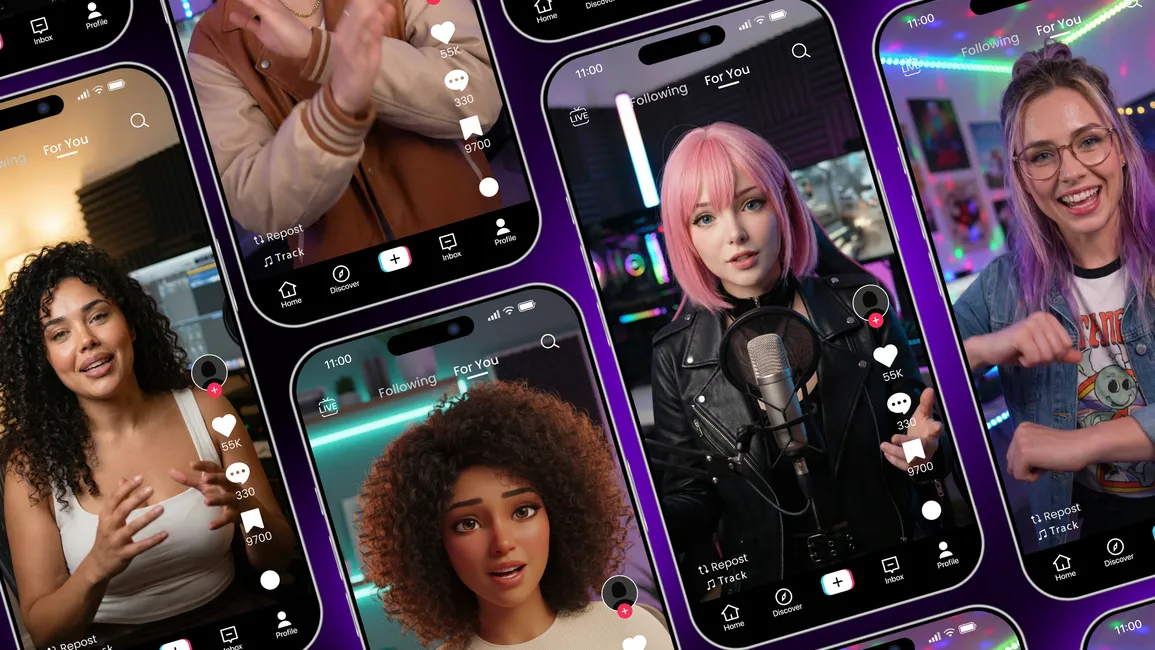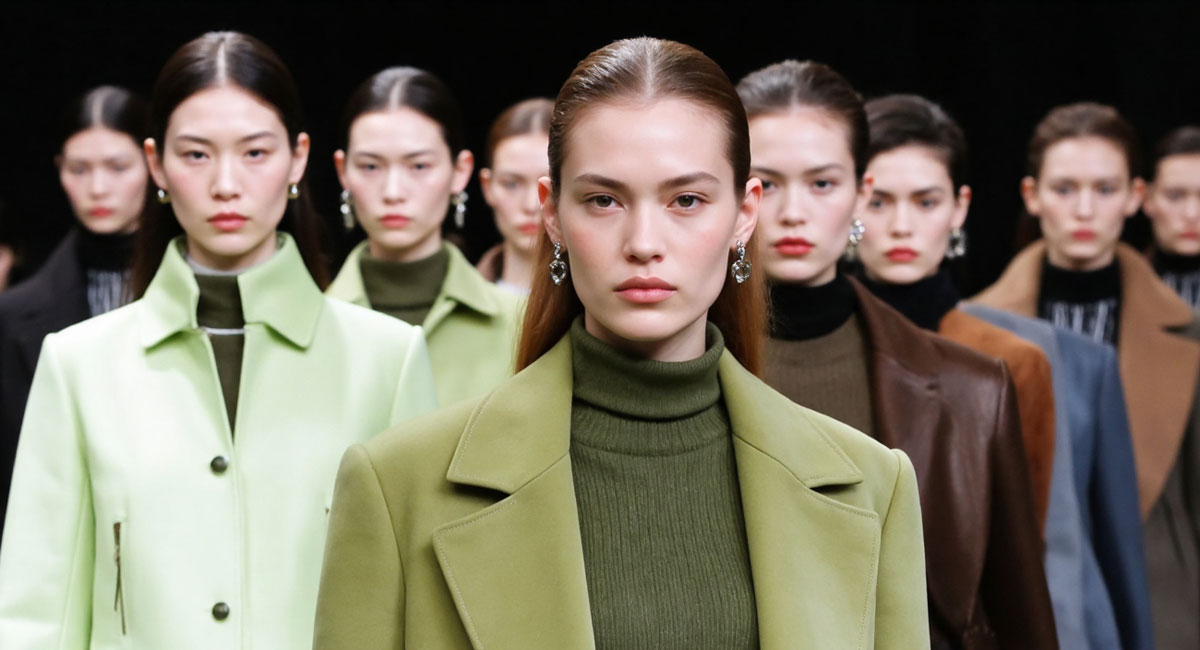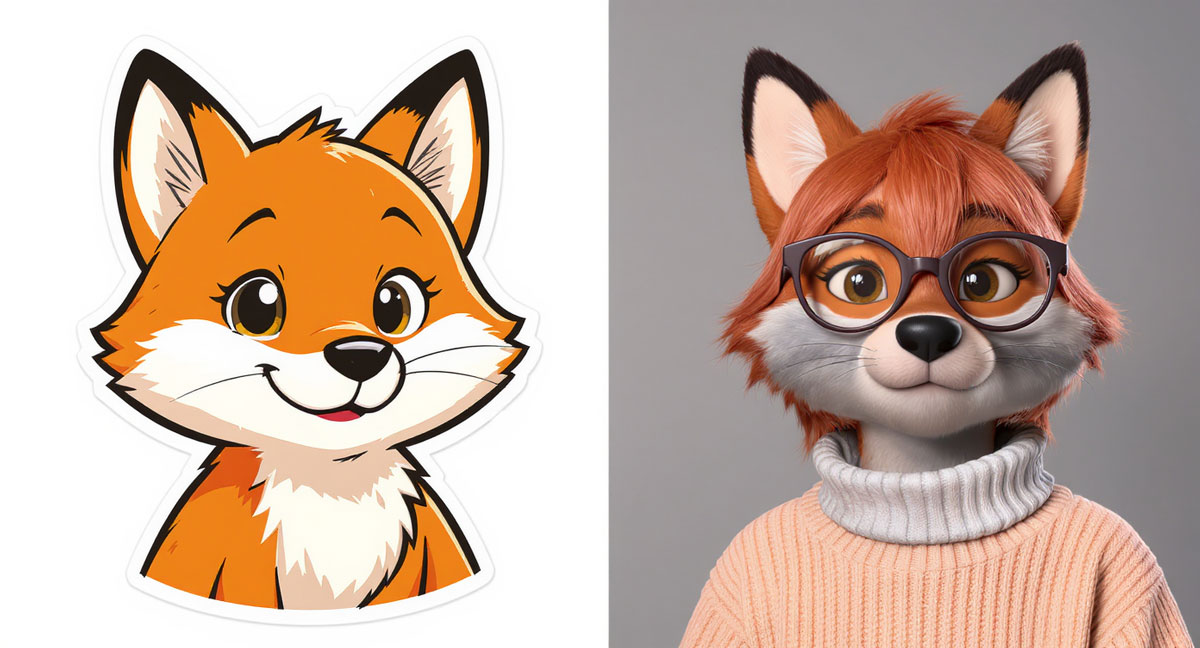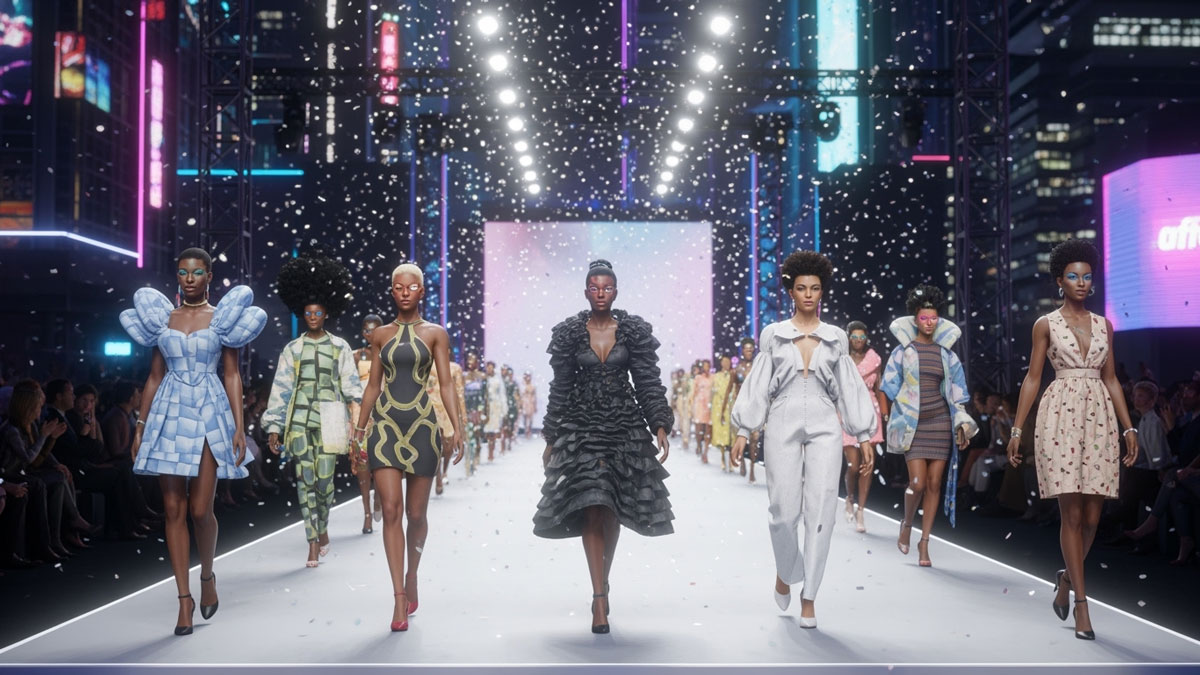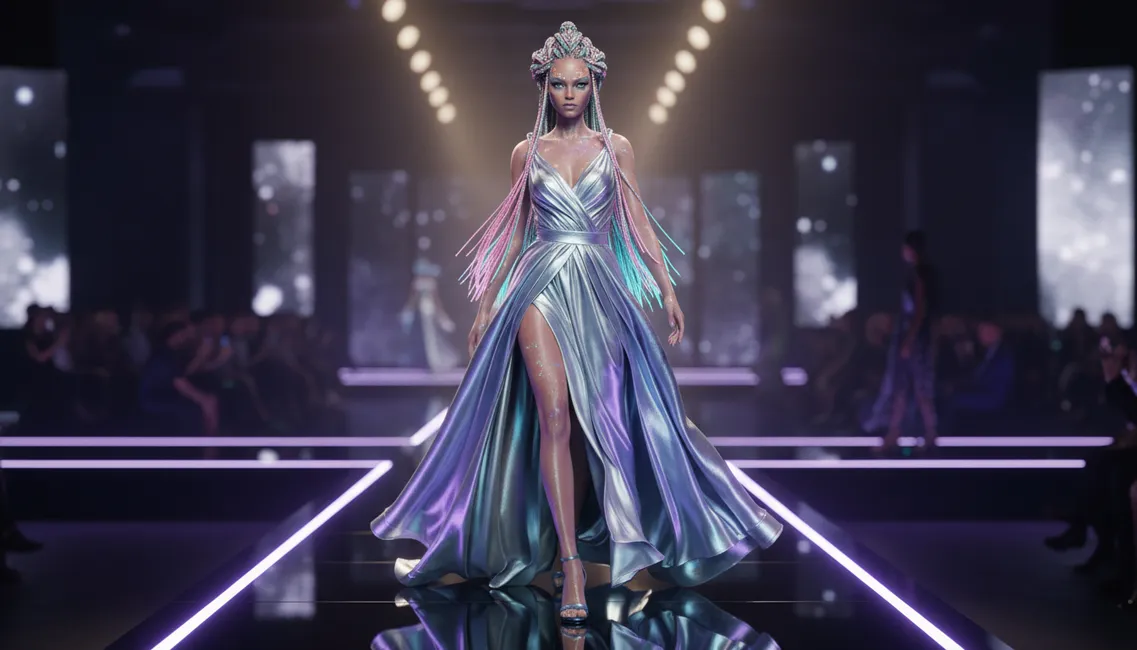
- Why Fashion Brands Are Stitching AI Models into Their Designs
- Examples of Leading Fashion Brands Using AI Models + Benefits and Challenges
- What Are the AI Fashion Marketing Trends to Watch? (2026 - Early 2030s)
- Do AI Models Exclusively Benefit Large Brands?
- Types of Virtual Fashion Models: What Fits Your Brand?
- Legal Risks, Ethical Concerns, and Strategies for Mitigation
- Need a Distinctive Face? Here is to Start
- All in All, Hesitation Means Being Left Behind
- FAQs
What if your next runway stars never age, eat, or demand a private jet, but still land million-dollar deals and break the internet?
With multiple top fashion brands using AI models to showcase their collections, this image is more than just a vision.
Levi’s just faced backlash for AI models that “faked” diversity, while Dior‘s virtual influencer Noonoouri struts eco-couture for 2.7 million followers, and H&M slashes photo shoot costs by 90% using digital twins.
So what’s holding you back from embracing this future-oriented trend?
Whether you’re a local fashion business owner or a global CEO, this article will explain why, in the $270 billion digital human economy, it’s wise to take actionable steps to launch your own virtual models, digital twins, or AI influencer.
I’m going to pull back the curtain on fashion brands using virtual influencers and AI models, highlighting real AI fashion campaign examples from luxury titans to fast-fashion disruptors.
I’ll unpack why brands are ditching human limitations for limitless digital personas, spotlight 12 trailblazing campaigns with AI fashion models vs human fashion models comparisons, tackle ethical landmines with battle-tested solutions, and map the future of AI in fashion marketing through the upcoming years.
Stay tuned.
Why Fashion Brands Are Stitching AI Models into Their Designs
Because Inclusivity Matters!
Gone are the days of just skinny, flawless hourglass figures dominating runways. Now, fashion giants are championing every body type: curvy, petite, tall, muscular, disabled, and even models with Down syndrome like Ellie Goldstein who slayed Gucci campaigns.
Or take how Rihanna’s Savage X Fenty revolutionized inclusivity with their iconic runway shows featuring wheelchair users, plus-size queens, and trans models. Tommy Hilfiger dressed Jillian Mercado, a Latina with spina bifida, while ASOS and Fenty Beauty showcase real stretch marks and vitiligo.
This shift isn’t just woke; it’s smart business.
Brands win hearts by showing EVERYONE belongs in fashion.
Digital, photorealistic AI fashion models allow for unprecedented diversity and inclusivity, celebrating underrepresented groups in ways that feel authentic and empowering.
No more waiting for the right talent; AI lets brands generate inclusive visuals on demand, reducing returns by boosting fit confidence.

Beyond Inclusiveness, the ROI and Efficiency are Compelling
While you’re reading this blog, virtual influencers are stealing the spotlight on platforms like Instagram, where multiple studies show they snag about 2.84% engagement rates; nearly double the 1.72% pulled in by human influencers in massive samples.
A Harvard Business Review breakdown even reveals that paid posts from these digital stars boost engagement by around 13% over their organic stuff.
It’s clear virtual talent can crush it in grabbing attention, though success hinges on nailing brand vibes and killer creative.
Over in Europe, Zalando‘s all-in on AI-generated imagery and “digital twin” models is paying off big time, per a report by Reuters. They’re slashing production from 6–8 weeks down to just 3–4 days, with costs plummeting 90%. And a staggering 70% of last quarter’s editorial shots came directly from AI.
That’s just one example of how these powerful evergreen assets supercharge efficiency and crank out content at lightning speed.
Cost-efficiency Is a Key Benefit
Traditional photography can cost thousands per shoot, but AI cuts timelines from weeks to days and expenses by up to 90%, as seen with European retailer Zalando.
Globally speaking, compared to traditional shoots (model fees, travel, studios, post), AI/virtual models can slash per-asset costs and dramatically compress timelines.
That’s a major reason why SKU retailers with many products and marketplaces are adopting these tools. Zalando’s data (see the previous section) shows some of the clearest savings reported so far.
Regionally speaking, in Europe, platforms are showing clear savings from AI. Meanwhile, in China, there is a similar move towards AI-driven content in live-commerce platforms like Taobao and Douyin, but there are fewer clear cost metrics available in public reports.
View this post on Instagram
Adopting AI fashion models isn’t just a smart move to stay top of mind; it’s essential for staying competitive in influencer partnerships and virtual brand ambassadors.
You’re not just saving money; you’re transforming brand storytelling with always-on digital personas that engage 24/7.
- Curious about the additional benefits that AI fashion models offer? Visit our blog “What’s an AI Fashion Model?” to learn more.
Want to make your brand stand out in a fresh and exciting way? A virtual influencer could be the game-changer you’re looking for.
If you’re ready to create a digital character that connects with your audience, we’re here to help.
Get in touch today to start building a virtual influencer that truly speaks to your fans.
Learn more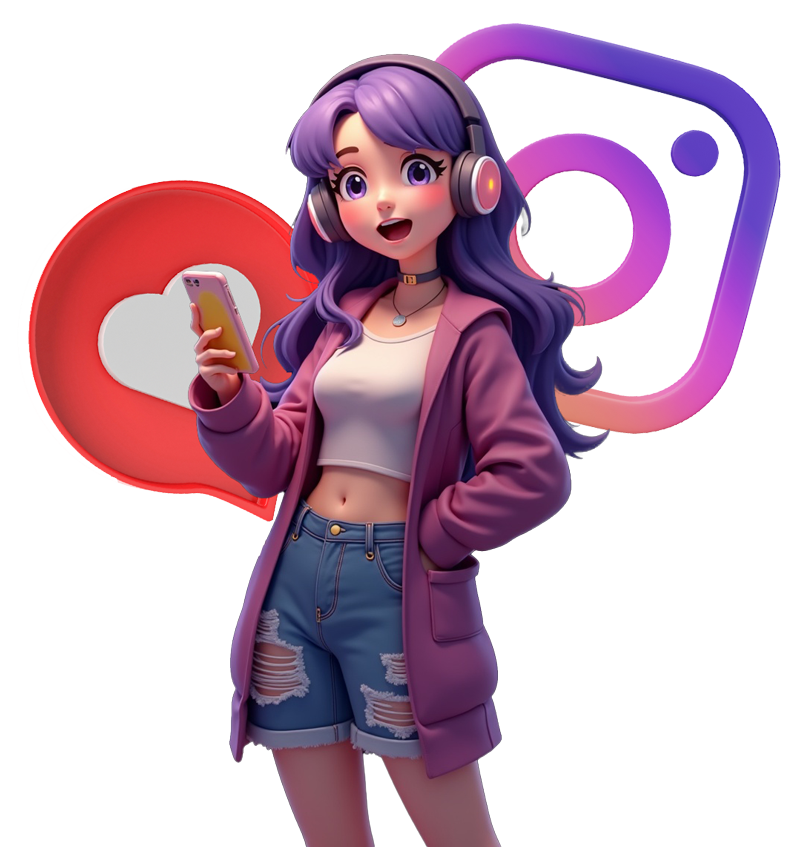
Examples of Leading Fashion Brands Using AI Models + Benefits and Challenges
Ready to be inspired?
Below are the prime AI fashion campaign examples of the real-world fashion brands using virtual influencers as models to drive innovation, engagement, and sales.
Luxury Fashion Houses
Dior: Blending Timeless Elegance with Digital Innovation
Dior has worked with social media icons like Noonoouri and Angela 3.0, a virtual version of Angelababy, to create digital marketing campaigns that blend couture with advanced tech.
Back in 2018, Dior broke new ground by featuring Noonoouri, a fully CGI virtual influencer and digital model, in a Rouge beauty product ad.
This wasn’t just a stunt; it was one of the first times a luxury brand leaned into the virtual influencer trend.
The goal?
Dior wasn’t chasing hard sales numbers (at least not openly). Instead, they were all about crafting a fresh, digital-first story to grab attention and spark excitement. By using a CGI model, they tapped into a bold, futuristic vibe that screamed innovation, aiming to pull in younger, tech-savvy crowds who live on their screens.
The campaign definitely turned heads. Using a virtual influencer was a daring move for a brand known for timeless elegance, and it got people talking.
But not everyone was sold. Some fans raised a fair point: how do you know what a lip color looks like on real skin when it’s shown on a digital doll? It’s a valid critique. Virtual models are cool, but they can leave you guessing about the real-world payoff.
Still, Dior’s experiment showed they’re not afraid to push boundaries and redefine how luxury connects with the digital age.
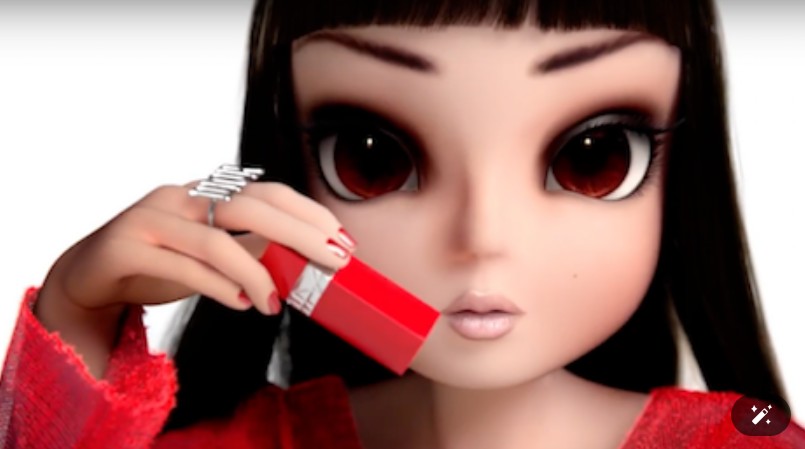
For its Pre-Fall 2021 collection, Dior took a bold step into the future by creating a digital twin of Angelababy, the Chinese celebrity and brand ambassador, to star in a high-profile virtual show.
Slapping a familiar face on a campaign to drive sales? Sounds cool. That wasn’t the only reason, though. Dior aimed to create a captivating digital experience, blending innovation with storytelling to deepen its connection with audiences, especially in China.
The move prioritized immersive brand vibes over hard-and-fast conversion goals, showcasing Dior’s knack for staying ahead in the digital game.
View this post on Instagram
Balmain: Empowering Diversity Through Virtual Supermodels
In 2018, Balmain collaborated with Shudu Gram, the world’s first digital supermodel and a virtual influencer, for the brand’s Pre-Fall / Fall-Winter campaign.
Instead of sticking to traditional models, Balmain went all-in on innovation by featuring Shudu alongside two fresh CGI avatars, Margot and Zhi. They called this trio their “virtual army”, and it was a bold move to showcase their collection.
What’s even wilder?
The clothes themselves were digitally crafted in 3D using CLO Virtual Fashion’s tech. Pretty forward-thinking, right?
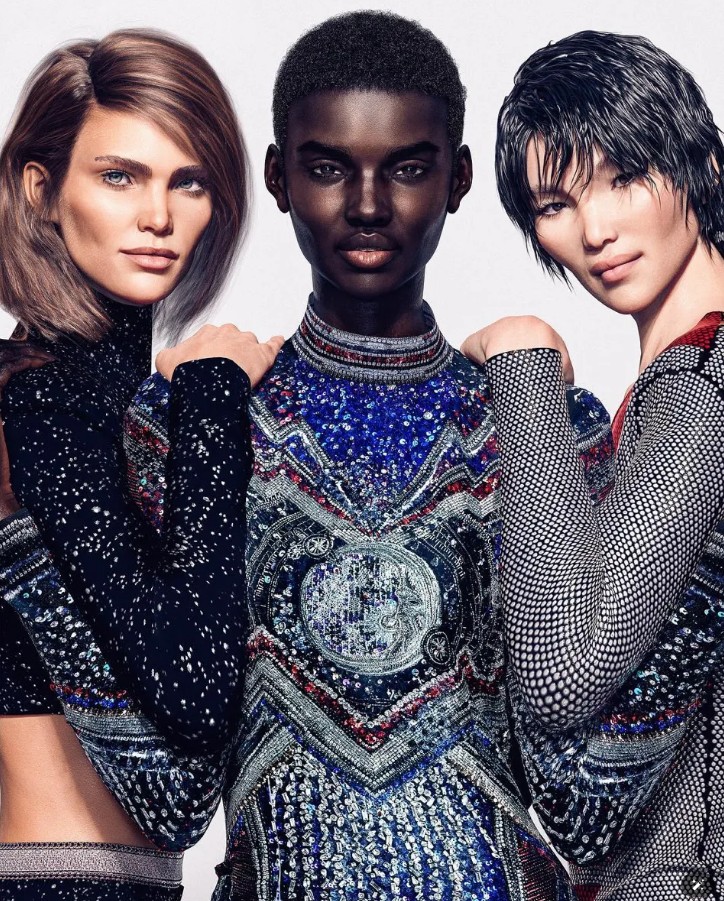
Prada: Pioneering AI in High-Fashion Storytelling
Prada’s ongoing collaboration with Lil Miquela began during Milan Fashion Week in 2018, where Lil Miquela, who’s not even real, took over Prada’s Instagram Stories, shared behind-the-scenes content, and also posted selfies of herself “at the show” while wearing head-to-toe Prada, like she was actually there.
Prada allowed Lil Miquela to use its Instagram account to drop GIFs from the #PradaFW18 collection and even launch a custom sticker pack on Giphy for fans to use.
It was a brilliant way to blend a digital character into the high-fashion scene, grabbing attention and sparking buzz among younger, social-media-savvy audiences.
The move screamed, “We’re Prada, and we’re just as cool online as we are on the runway”.
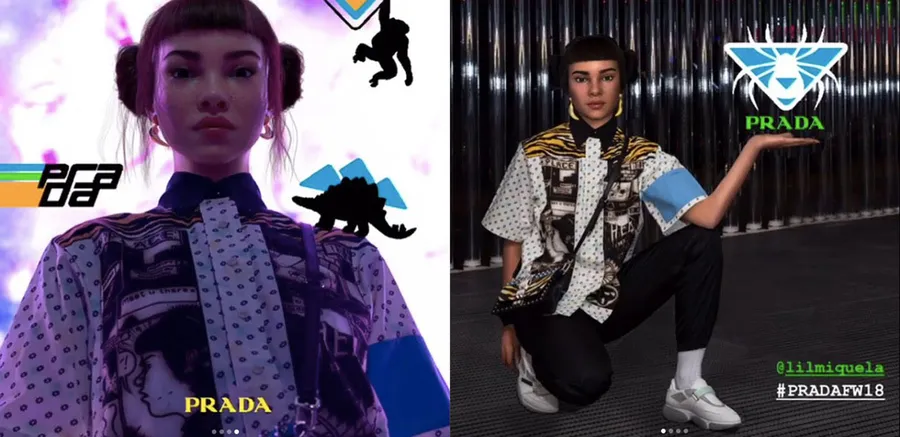
Prada kept the vibe going with Noonoouri to stay relevant with Gen Z and flex their digital savvy. Then, with the Candy campaign, Prada created their own virtual muse for their fragrance line, blending short films, social media, and print to hook tech-loving consumers.
Louis Vitton: Proving the Way for Later Virtual Collaborations
In 2013, Louis Vuitton dressed Hatsune Miku, a Japanese virtual pop star, in the brand’s SS13 Damier looks for “The End”, a groundbreaking digital opera with no human performers.
A life-size Miku figure in the Louis Vuitton outfit popped up to promote shows in Tokyo and Paris.
The collaboration wasn’t a typical ad; it was a smart cultural move hinting at the potential of virtual spaces for fashion.
Global Fast Fashion Brands
H&M: Redefining Fashion with Digital Twins
In 2025, H&M rolled out a wild idea: Creating digital twins of 30 real models (with their full consent and ownership) for marketing and social media campaigns, revolutionizing e-commerce photography.
Using digital twins let H&M nail production by tapping into data-driven insights, perfectly matching output to what customers want.
It cut down on overproduction and waste while speeding up the whole process. Plus, the human models got a sweet deal: they were able to handle more jobs remotely while skipping exhausting travels
This approach keeps H&M’s vibe human-focused, staying true to its core of putting real people front and center, making fashion more inclusive, creative, and planet-friendly.
The payoff?
Generative tech supercharged content creation: quicker turnarounds, endless location and angle options, and a fresh set of creative tools to play with.
The move sparked some controversy, however.
Critics say it might slash jobs for models, photographers, stylists, the whole crew, while some question if these AI clones are truly authentic and how fair pay works for a “digital you” that lasts forever.
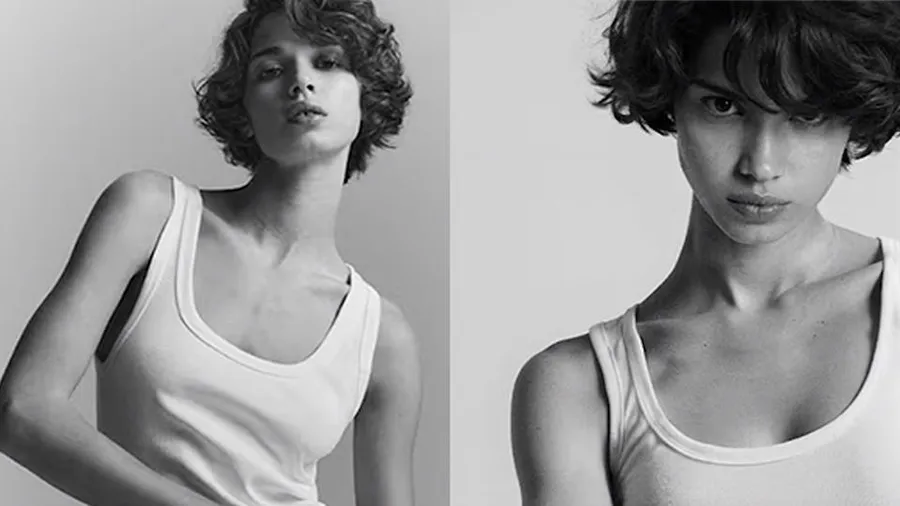
Zalando: Operationalizing AI for Massive Savings
In May 2025, Zalando announced they’re using generative AI to whip up “digital twins” of models. Think of 3D, virtual stand-ins for real people, ready to shine in ad campaigns and product pages. A smart move indeed!
According to Reuters, 70% of Zalando’s editorial campaign images in Q4 2024 were already AI-crafted, showing they’re all in on this tech.
Unlike H&M or Mango, which’ve leaned into flashy “virtual influencer” campaigns with branded avatars, Zalando’s keeping it practical. Their focus is on the nuts and bolts: streamlining operations, slashing costs, and boosting efficiency.
Zalando’s forward-thinking approach is less about social media buzz and more about making a direct, measurable impact on the bottom line, all while moving fast.
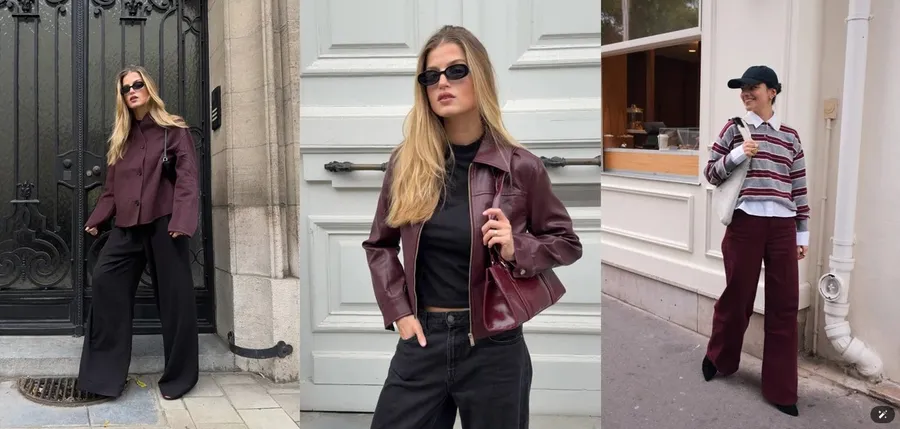
Sportswear Brands
Adidas: Blending Physical Product Release with Digital Culture
In 2021, Adidas Originals collaborated with Ruby 9100M, a self-styled “transhowman” half-robat half-human avatar, to launch the “Ozrah” sneaker.
The collaboration was exceptionally framed as a “virtual girl” design partnership. Ruby was a co-creator, fusing virtual fashion with a real-world product. This move let Adidas dive into the metaverse hype, mixing digital culture with physical kicks to grab attention from tech-savvy fans.
The strategy?
Stay fresh for younger, digital-first audiences, stir up buzz, and flex innovation in the fashion-meets-tech space.
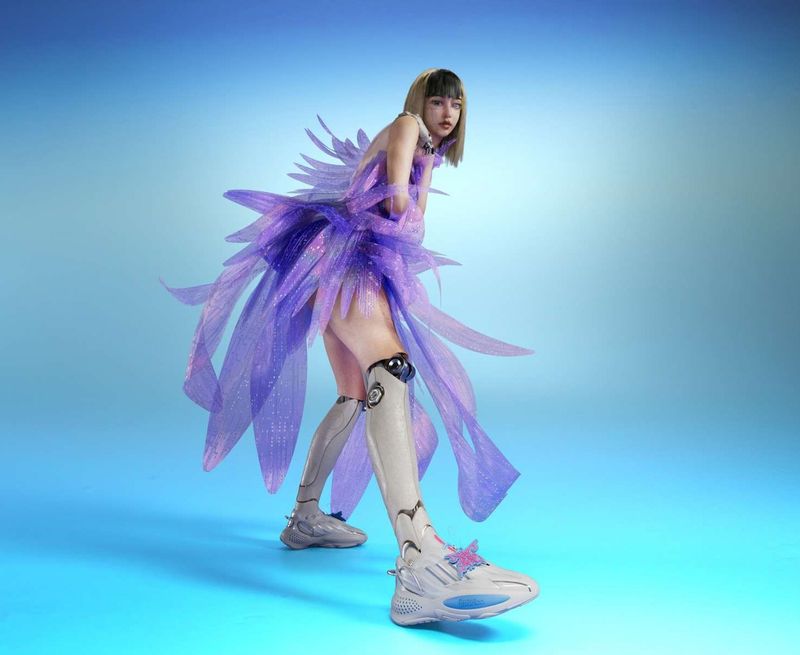
Adidas also worked with Imma Gram, a Gen Z-loved CGI influencer, to strengthen its digital cred.
Unlike Ruby’s deep co-creation role, Imma’s involvement was lighter. She rocked Adidas gear as a virtual trendsetter. This approach, especially hot in Asian markets where virtual influencers are huge, keeps Adidas culturally sharp and modern-looking.
The payoff?
Tough to pin down, but it’s all about vibing with digital natives and signaling Adidas is ahead of the curve.

Nike: Playing Smart to Reach Digital Native Audience
Informal sources report that Imma Gram is collaborating with Nike. This move shows Nike’s diving headfirst into the digital world to vibe with younger, tech-obsessed fans.
Mid-Market Brands
Levi’s: Championing Diversity with AI Models
In March 2023, Levi Strauss & Co. (Levi’s parent company) announced a partnership with Lalaland.ai to roll out something pretty cool: AI-generated, ultra-realistic models for their product photos.
These digital stand-ins aren’t just replacing human models; they’re stepping in to give customers a more personalized vibe. Shoppers can now see clothes on avatars that match their own look, making the whole experience more relatable, engaging, and satisfying.
Here, we aren’t talking about typical social media “virtual influencers” with catchy names and fake personalities. Instead, these digital models were designed for one job: showing off Levi’s gear in a way that clicks with diverse customers.
The move is a savvy one, a win for representation and efficiency, plain and simple.
Calvin Klein: Blending Reality and Fiction
In 2019, Calvin Klein’s “#MYCALVINS” campaign dropped a bold 30-second ad featuring supermodel Bella Hadid kissing CGI influencer Lil Miquela.
This groundbreaking move was the brand’s first major use of a virtual influencer in a global campaign. The campaign nailed its goal of grabbing attention and pushing boundaries in advertising.
The ad, part of a star-studded series, went viral, sparking heated debates. Some accused it of “queerbaiting”, prompting Calvin Klein to apologize publicly and clarify their intent to provoke thought and discussion.
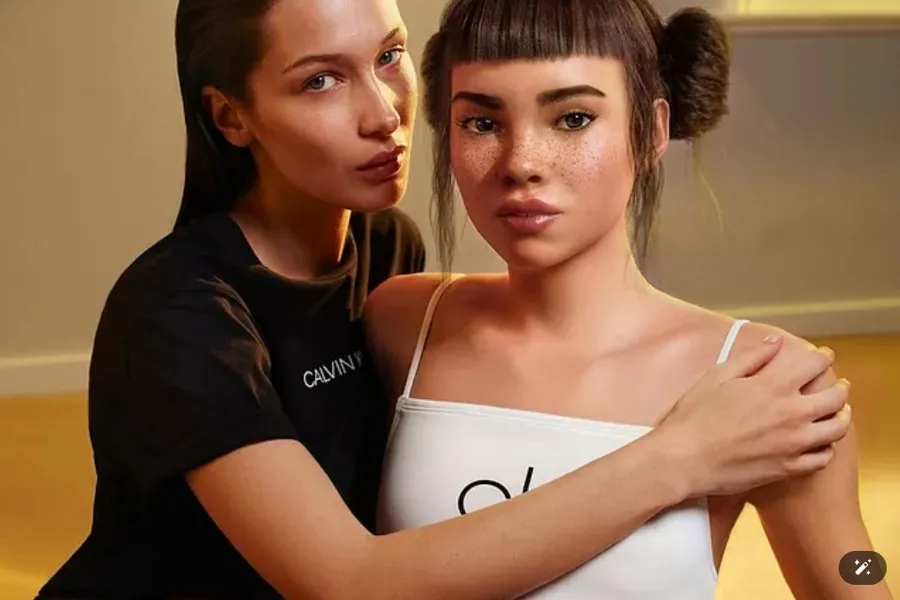
Calvin Klein’s 2019 Eternity campaign, backed by Coty, cleverly used Noonoouri to promote the iconic fragrance on Instagram.
Instead of a full-blown film, this was a beauty-focused, social-media-driven effort, with Noonoouri’s posts tagged #FORALLETERNITY and #eternity.
Coty’s ongoing partnership with Noonoouri across its luxury brands, including Calvin Klein, showed an early embrace of virtual influencers in high-end beauty marketing.
This move blended Eternity’s classic charm with a forward-thinking digital strategy, proving that prestige beauty could thrive in the virtual space while engaging audiences in a fresh way.
View this post on Instagram
Guess and I.N. Official: Revolutions Fueled by AI
In 2025, Guess, the iconic lifestyle brand, turned heads by debuting an AI-generated fashion model in the pages of Vogue Magazine: a stunning, blonde AI model rocking Guess’s latest looks in a series of jaw-dropping ads.
The campaign stirred up buzz, sparking heated debates about beauty standards and what this means for human models’ careers. Is this the future, or just a flashy stunt?
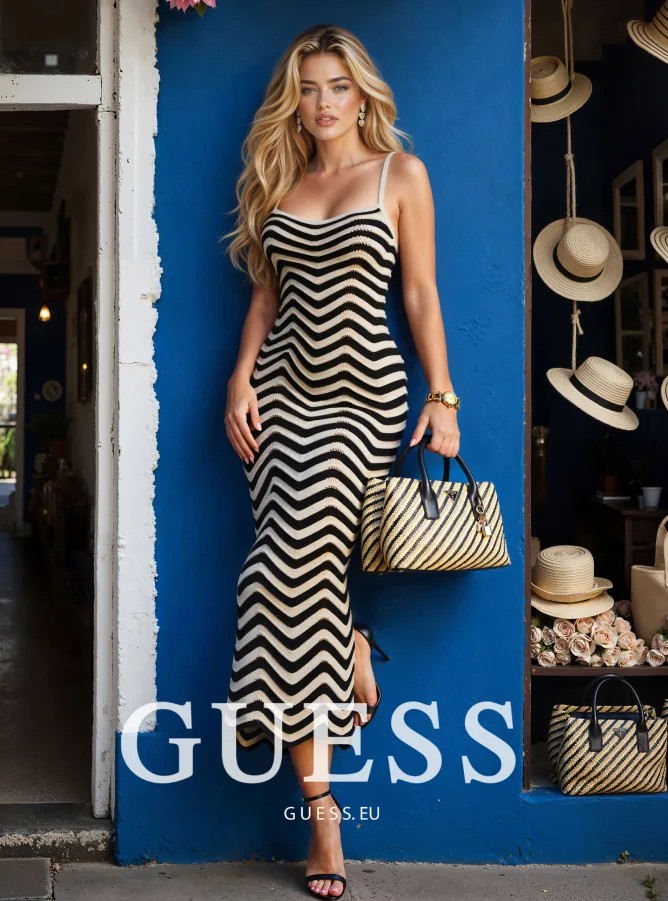
Meanwhile, over at Africa Fashion Week London, “Transcendence”, the first-ever fully AI-designed fashion collection was launched by Meta in partnership with Nigerian designer I.N. Official.
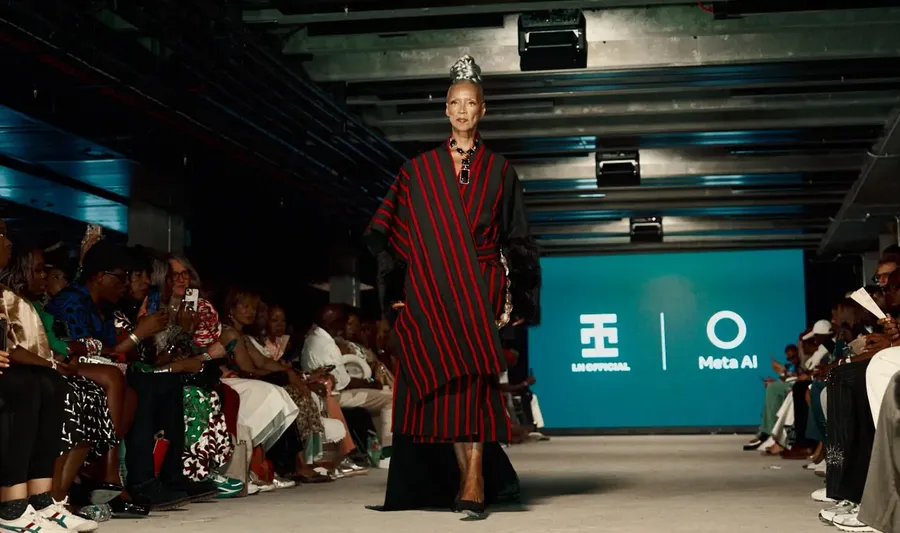
So, What’s the Big Picture?
The case studies of the brand using AI fashion models and virtual influencers represent a clear picture of how AI’s shaking up the fashion industry in ways we couldn’t have imagined.
And Guess’s Vogue feature proves it’s not just hype. The fashion world’s evolving fast, and AI’s leading the charge, blending innovation with style in a way that’s impossible to ignore.
What Are the AI Fashion Marketing Trends to Watch? (2026 – Early 2030s)
AI’s set to revolutionize fashion commerce, and it’s already making significant strides, from Immersive VR and AR shopping experiences, along with digital showrooms, and predictive analytics that enable brands to accurately forecast trends and curate ideal collections.
They’re no longer just concepts; they are becoming a reality.
By 2027, expect campaigns to get even smarter. Picture matured versions of the likes of Lil Miquela taking interactive roles. They’ll be engaging directly with consumers in real-time, hosting live sessions in virtual environments, and complementing human talent.
Regionally, China is leading in the integration of AI and live commerce in the form of live streaming plus digital influencer/AI avatars.
Meanwhile, Europe is carving out its own path, doubling down on ethical AI frameworks to ensure responsible innovation in fashion and retail, setting the standard for “ethical scaling” in fashion tech.
The Numbers? They Speak for Themselves
The virtual influencer/digital human global market exploded to USD 6.06 billion in 2024, barreling toward USD 170.2 billion by 2034. The AI fashion model sector is following suit, growing at a blistering pace.
Take a look at these eye-opening insights from the BoF–McKinsey State of Fashion 2025 report:
45% of fashion executives view generative AI in marketing as a valuable opportunity. What does it suggest? We’ll witness a rapid shift towards using AI and virtual talent for content creation, even in a cautious economic environment.
Overall, predictions for AI in fashion suggest growth of over 30-40% throughout the decade.
In Europe, major online retailers like Zalando are already setting trends. Korea and Western Europe are also showing promising growth in AI applications within fashion, with expectations of similar high growth rates, projected to reach USD 6.99 billion at a compound annual growth rate (CAGR) of 41% through 2029, as Research and Market reports.
Additionally, China‘s thriving creator economy and live-commerce platforms are likely to boost the use of virtual talent even further.
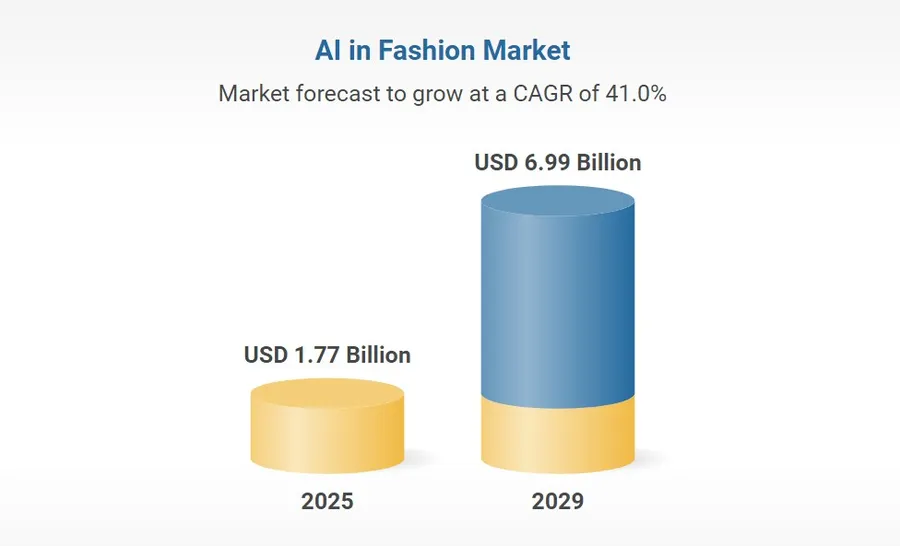
What can we infer from these statistics?
Let me put it plain and simple: fashion brands using AI models and virtual influencers aren’t simply experimenting; they’re rewriting the rules of engagement, diversity, and profitability.
- If you’d like to know how virtual influencers drive value for brands, check out our blog “Virtual Influencer Marketing: a Complete Guide”.
Do AI Models Exclusively Benefit Large Brands?
It’s yes and no at the same time.
You don’t need a massive budget to join the AI revolution. Small businesses can start with affordable tools of AI platforms.
That said, it’s not a magic bullet.
Virtual fashion models are powerful marketing tools, but a successful marketing campaign requires more than just stunning visuals; It demands expertise in marketing across various digital channels, advanced skills in utilizing technology, a deep understanding of character and storytelling, and a well-thought-out business strategy that integrates all these elements effectively.
For large businesses with complex marketing needs and significant budgets, or for those looking to invest in their future, partnering with an AI fashion agency like Dream Farm is a smart, low-risk solution
Want to make your brand stand out in a fresh and exciting way? A virtual influencer could be the game-changer you’re looking for.
If you’re ready to create a digital character that connects with your audience, we’re here to help.
Get in touch today to start building a virtual influencer that truly speaks to your fans.
Learn more
Types of Virtual Fashion Models: What Fits Your Brand?
That’s an important question to consider. Let’s compare the available options and examine the factors to take into account for each choice.
CGI Virtual Influencers as Campaign Faces
If you’re seeking total creative control, 24/7 availability, and global social media reach, consider this brand-safe and endlessly restylable option.
Shudu, Lil Miquela, and Prada’s Candy are good examples of fully CGI stars reshaping luxury brand storytelling.
While scalable once created, the initial cost of asset design and animation is steep.
Fashion brands using AI models must tread carefully to avoid authenticity backlash, especially if replacing real representation.
AI-generated 2D e-Commerce Models
Look for a way to slash weeks off your product shoots while saving a ton of cash, just like Levi’s did? Don’t miss out on this option.
AI-generated 2D e-commerce models are photoreal digital figures that wear your product for PDPs and catalogs, offering instant size and skin-tone diversity without endless reshoots.
However…
Watch out for backlash on “artificial diversity” and emerging disclosure rules.
Digital Doubles and Twins of Human Models
Remember H&M’s digital twins? Picture capturing a model’s exact likeness as a high-fidelity digital twin for films, lookbooks, or epic launches like Balenciaga’s Afterworld.
This option allows you to place talent in impossible locations or run multiple shoots at once. The process is intensive but pays off with reusable assets across seasons.
Just tread carefully.
Likeness rights, ethical use, and union scrutiny are real hurdles. While scalability’s solid, contracts need precision.
Partner with Dream Farm Agency’s virtual influencer service and leverage the power of virtual twins for real-time magic.
“Be Your Own Model” Avatars
Imagine shoppers uploading a photo to see themselves in your clothes! Consumer-personalized avatars, like Walmart’s Zeekit or Reactive Reality’s PICTOFiT, plus the emerging body-scan tech, let customers try outfits virtually, boosting fit confidence and slashing returns.
Just ensure privacy policies and accuracy claims are airtight to build trust.
Metaverse and Game Avatars
Want to hook Gen-Z where they live?
Metaverse and game avatars, like Gucci’s Fortnite skins or Louis Vuitton’s League of Legends collabs, are your ticket.
Platforms like Zepeto, Roblox, and Ready Player Me let brands dress digital avatars, driving engagement and new digital revenue streams.
Scalability’s off the charts with platform distribution and user-generated content, but you’re tied to their ecosystems, so native creative is key.
It’s a bold move for leaders eyeing younger audiences, though platform dependence is a risk. Zepeto and Ready Player Me are ones to watch for cross-platform potential.
AI Models for Fully Virtual Runaways and Garment-driven Shows
Picture a runway where the clothes steal the show, no model needed.
Fully virtual runways, like Hanifa’s 3D “ghost” show, offer wild creative freedom, cut pre-production waste, and boost sustainability.
They’re a bit heavy on asset prep but shine across social and video.
The catch?
Without a star model, personality can dip, and 3D quality must be top-notch to feel premium.
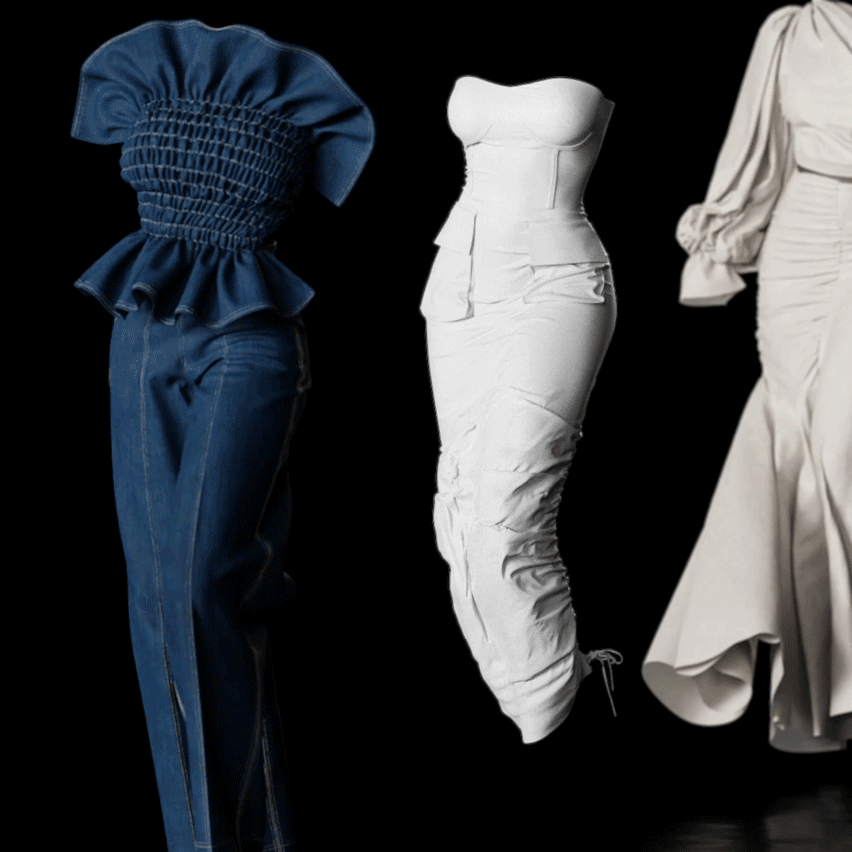
Legal Risks, Ethical Concerns, and Strategies for Mitigation
Can using AI fashion models or virtual influencers raise issues for brands?
Well, every innovation has hurdles. AI fashion marketing is no exception.
Fashion brands using AI models are often criticized for issues like unrealistic beauty standards, potentially fueling body image concerns or eating disorders from “perfect” bodies.
Plus, the New York Fashion Workers Act of June 2025 mandates protections for models, including consent for digital twins.
The act doesn’t ban brands from using digital twins; it regulates their use through consent and transparency.
How to eliminate the risk?
Prioritize ethical AI use by obtaining explicit consent and compensating for digital twins. Comply with GDPR for data protection, and label AI content.
What’s on the Hook Legally?
Say it when an AI fashion model or an AI influencer is in an ad.
In the U.S., the Federal Trade Commission (FTC) requires clear and obvious disclosures if an ad involves a paid relationship or free products.
This applies to everyone involved, brands and creators alike. You must be clear in every format, like captions, on-screen text, or voiceovers.
If you’re using an AI-generated fashion model or influencer, you must also disclose that they’re artificial to avoid confusing people with their realistic appearance.
Be Upfront about AI-generated Content
In the EU, the AI Act requires you to inform people if content is AI-generated or significantly altered, like deepfakes.
The Digital Services Act (DSA) also demands transparency in ads (including AI-generated ones) and bans targeted ads to minors (anyone under 18 years old) on platforms.
Get Written Consent When Using Names, Faces, and Voices
If your ad uses someone’s face or voice to identify them, you generally need their explicit permission.
Under the EU’s GDPR (Article 9), using biometric data like faces or voices counts as sensitive “special-category” data. You’ll need a legal basis (often explicit consent), a Data Protection Impact Assessment (DPIA), and to minimize data use.
In the U.S., likeness rights protect a person’s name, face, or voice from being used in ads without permission. States like California and New York have specific laws, including rules for “digital replicas”.
Purely Machine-generated Works Aren’t Copyrightable
In the U.S., purely AI-generated content can’t be copyrighted. When using AI in creative work, disclose the AI’s role and only claim copyright for the parts humans create.
*** Important note:
Different countries may have unique rules for using AI-generated content. To stay safe, make sure to review, understand, and follow these regulations.
What Do Platform Rules Say about Virtual Characters?
Do social platforms allow activities for virtual characters?
Yes, Meta (Instagram, Facebook, Threads), TikTok, YouTube, X, Snapchat, and Twitch do, as long as you follow their rules. This means clearly disclosing ads, labeling realistic AI-generated content, and sticking to their policies on impersonation and safety.
What should you watch out for?
- Missing #ad or platform label
- Confusing realism
- Suggesting endorsement without rights
- Using faces or voices without a lawful basis
- Misleading synthetic avatars
- likenesses and IP, privacy violations
Ethical Pressure Points on Brands Using Virtual Influencers
Beyond rules, there’s a growing call to embrace diverse body types and move away from unrealistic beauty standards and body image.
How to avoid the pitfalls?
Ensure your avatars and human talent reflect a diverse mix of sizes, ages, skin tones, disabilities, and gender expressions.
Stick to a “no body morphing” rule; don’t tweak bodies into unrealistic shapes.
Fashion brands using AI models must always clearly mark retouched or synthetic imagery when needed to maintain trust and authenticity. If local laws (like in France) require retouching labels, use them and keep edits minimal.
Finally, for younger audiences, steer clear of weight-loss talk, age-gate sensitive filters, and back up beauty claims with solid evidence.
View this post on Instagram
Job displacement is another risk. AI can definitely shake things up for jobs like photographers, stylists, and other creative roles.
How to mitigate?
There are solid ways to soften the blow like keeping humans involved, either on screen or behind the scenes, or setting aside a small chunk of your budget (like 1–2%) to train people in new skills, like prompt design or 3D development.
Need a Distinctive Face? Here is to Start
Thinking about creating your own AI fashion models? DIY platforms might seem like a budget-wise option, but they often focus only on design.
Top-tier influencer marketing agencies begin with brand strategy. That’s why smart fashion houses choose to rely on those agencies’ expertise rather than relying on DIY work.
A tailored marketing strategy acts like a roadmap, guiding your digital presence with precision and flair, ensuring your content flows effortlessly across platforms, while weaving stories that hook your audience and keep them scrolling. No missteps, no dead ends
And then there’s the bigger picture: integrating AI for interactive experiences, conducting representation audits, and navigating the technical, legal, and ethical details to make your next seasonal collection truly stand out.
At Dream Farm Agency, we’ve assembled talented teams to guide you through every step of the process, from creating stunning hyper-realistic visuals to integrating AI technology for immersive experiences and telling stories that attract digital-native Gen Z.
The story doesn’t end here. There is much more to AI models than meets the eye.
We think ahead, enabling you to transform your unique digital personas into dynamic virtual influencers with IP, maximizing the value of your investment.
All in All, Hesitation Means Being Left Behind
Digital humans are reshaping fashion, bringing unmatched diversity, efficiency, engagement, and innovation to the table.
From Dior’s tech-enhanced fashion campaigns to Levi’s inclusive push, fashion giants are showing how virtual stars are inspiring action.
Embracing futuristic trends ensures your enduring presence in today’s competitive digital fashion market. Meanwhile, transparency and ethics are key to building lasting consumer trust.
Possibilities? Truly endless.
Partnering with us is like opening a door to that limitless potential for growth. With our expertise in branding, AI and character-centric storytelling, you’ll shape the future on your own terms, setting new trends instead of following what’s popular today.
Here is how to start. Reach out to us today; let our experts guide you on this exciting journey.
FAQs
Which AI influencers collaborate with fashion brands?
Top ones include Lil Miquela (Prada, Calvin Klein), Shudu (Balmain), Noonoouri (Dior, Prada, Calvin Klein), and Imma (Adidas).
How much do AI models cost compared to traditional fashion photography?
AI slashes costs by up to 90%, from thousands per shoot to hundreds, with faster timelines. Traditional methods involve model fees and logistics, while AI offers scalability.
What should brands disclose when using virtual models and AI influencers?
Brands must label AI content for transparency. Comply with laws like GDPR and the NY Fashion Workers Act for consent and ethical use.
What types of AI or technology are behind these models and influencers?
Technologies include CGI for photorealism, machine learning for personalization, and generative AI like DALL-E or Midjourney. Digital twins use scans, while virtual influencers rely on AI for interactive behaviors.
Is there any brand that has replaced human models completely with AI fashion models?
Not entirely. Brands like Zalando use 70% AI imagery, but hybrids prevail. Full replacement is rare due to authenticity needs, though it’s growing in e-commerce.
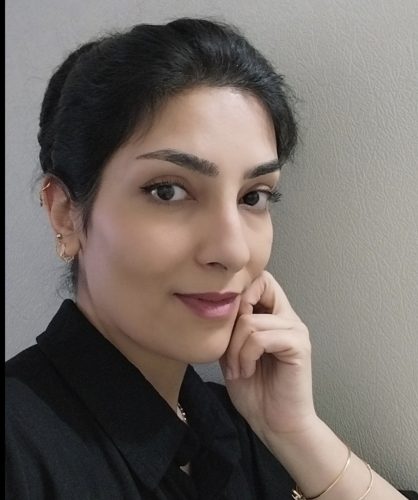
Leila
